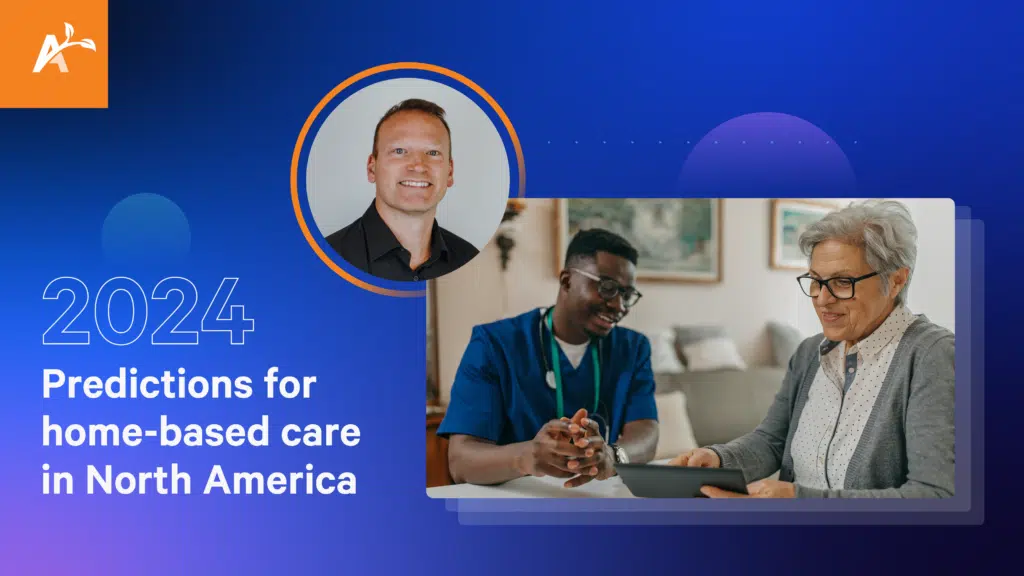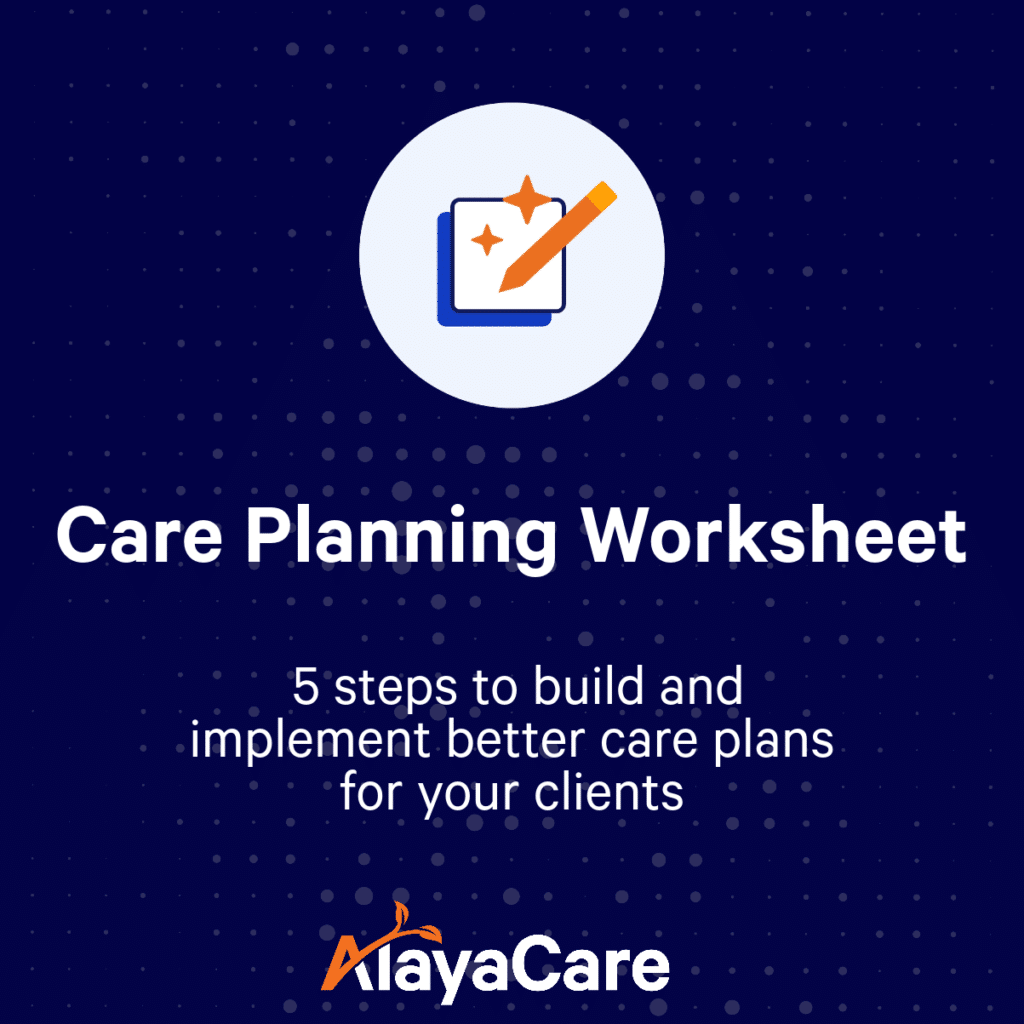Blog
Predictions for home-based care in 2024 in North America

Author: Adrian Schauer, CEO of AlayaCare
A year ago, we anticipated the industry gearing up to manage repetitive tasks more efficiently. With economic and resource restraints, we see the industry embracing the opportunity to achieve more with less through solutions such as Artificial Intelligence (AI), highly personalized care plans, the adoption of integrated care models, and more.
Here are my top predictions for the future of home-based care in North America and specific trends emerging in home health, home care, and home infusion in the US and Canada.
1. Continued proliferation of AI and machine learning in health care

Artificial Intelligence (AI) will continue to revolutionize the home-based care industry in North America by 2024. The transformation will be so significant that it will alter how we approach home-based care.
2023 is the year that generative AI and conversational computing really hit the public consciousness, most famously via the launch and rapid ascent of OpenAI’s ChatGPT. AlayaCare announced the release of its proprietary AI Chatbot, Layla by AlayaCare, at our Better Outcomes conference in September. We demonstrated a clinical assistant use case, whereby Layla messages a care worker minutes before a visit starts with a summary of changes in the client’s condition since their last visit. The care worker at the point of care is then also able to inquire about risks the client faces and get additional information about health conditions and care pathways.
These types of use cases have the potential to improve patient outcomes and build the confidence and capabilities of clinicians and caregivers, who often describe the isolation and anxiety of clinical decision-making at the point of care without access to peers.
In addition, I cannot overstate the importance of AI in doing patient risk stratification, detecting health anomalies, and boosting collaboration, communication, and efficiency between each stakeholder in the care continuum. AI also provides predictive analytics, enabling caregivers and nurses to identify and address potential health issues early on.
Take AlayaCare’s Notable as an example; this feature uses natural language processing (NLP) algorithms to detect important information from patient notes and documentation. This tool uses AI to predict and prevent adverse events and improve overall patient outcomes.
It’s a paradigm shift in care delivery, allowing us to move from reactive to proactive care management in all home-based care markets.
Here are areas of transformation we can see in home-based care:
A. Natural Language Processing (NLP) in virtual assistants
Virtual assistants equipped with NLP capabilities will become commonplace in this AI revolution. Take our upcoming ‘Layla’ as an example. Layla by AlayaCare— the first and only Smart AI assistant for home-based care relying on Large Language Models to help staff and caregivers reduce repetitive tasks and focus on providing care. Layla will help clients and patients interact with their care plans seamlessly, delivering information in a conversational manner that enhances the patient and client experience.
There are also compelling operational use cases enabled by conversational computing. With secure messaging as the interface, Layla can interact with all members of the care team, including case managers upstream in the care continuum. One of the more popular use cases in beta tests is around Layla confirming care workers’ availability for the week and proposing shifts/visits that may appeal to them. The capability to remove human drudgery from the delivery of home-based care and improve operational efficiency are endless.
Read our press release on AlayaCare’s Better Outcomes user conference highlighting the importance of AI and tech for the future of home-based care.
B. Clearer regulatory frameworks for AI in healthcare and home-based care
Looking ahead to 2024, we can anticipate more precise rules for using AI in healthcare and home care. These guidelines will ensure that with AI ethically, patient and client data are kept private, and AI algorithms are monitored. It means better safety for individuals and assurance that the book does everything. According to Modern Healthcare, Health-tech companies should take the lead and collaborate with health systems, large technology companies, and federal regulators to develop frameworks.
Canada has already taken a step in that direction and recently launched its voluntary AI code of conduct for advanced AI systems capable of generating content in the fall of 2023. Some health tech companies, such as AlayaCare, signed to show that they follow these guidelines. It’s an exciting time for home healthcare, where technology and regulations work together for the best care and better outcomes.
Over the past few years, AI has been moving from experimental stages to practical applications. By 2024, the integration of AI into home-based care will be not only possible but also essential. Furthermore, the pandemic has accelerated the need for remote patient monitoring, telehealth services, and better software to help organizations keep up with the increased demand —making 2024 a pivotal year for AI’s widespread adoption in home-based care.
2. Value-based care model expanding and pushing data connectivity

The year 2024 will be pivotal for the home-based care industry as the value-based care model becomes more prevalent since it began testing in the US. This model, which emphasizes outcomes over the volume of services, will start to expand and create an increasingly significant impact on how home-based care organizations operate.
Here’s what we can expect:
A. Integration of Social Determinants of Health (SDOH)
The value-based care model in 2024 will likely incorporate a deeper understanding and integration of social determinants of health. Providers will start addressing non-medical factors influencing patient well-being, such as housing, education, and access to healthy food, which means a more complete, holistic approach to patient care. Recognizing and addressing these social determinants can reduce the health differences between different communities. That’s a step towards greater health equality.
B. More data integration between healthcare organizations and providers
As we look towards 2024, I anticipate a significant rise in data integration across healthcare organizations and providers. This change will be driven by the shift towards value-based care, making it easier for primary care facilities, hospitals, and home care providers to share information and coordinate care effectively.
During last November’s HealthTech Ignite panel discussion, I highlighted how introducing incentives into the healthcare value chain can fuel this transformation. In simpler terms, when you reward healthcare providers for delivering high-quality care, they’re more likely to adopt technologies that enable better coordination and information sharing.
C. Expansion into Canada
While the US tested the value-based care model, it’s likely to expand into Canada in 2024. The introduction of the value-based care model will significantly change the Canadian healthcare system, focusing more on care outcomes rather than the number of treatments. This shift will also make working together easier for Canadian and US healthcare providers. We can share knowledge, resources, and best practices with similar systems more effectively.
The shift towards a value-based care model will lead to improved client and patient outcomes and transform how home-based care is delivered.
Learn more about the value-based purchasing pilot in the US, what to expect moving forward, and how organizations can thrive in this new marketplace.
3. Care plans will become highly personalized

One-size-fits-all healthcare is on the brink of extinction. It’s becoming increasingly clear that each client has unique needs and preferences that demand individual attention. In 2024, the industry in North America is likely to move towards highly personalized care plans.
Here’s what we can expect:
A. Increased utilization of data analytics to create custom care plans
In 2024, caregivers will harness the power of advanced algorithms coupled with rich client data to create these custom care plans. Caregivers can now consider factors such as age, gender, medical history, and lifestyle to tailor a care plan that aligns perfectly with each client’s specific needs.
B. Better understanding of social determinants of health (SDOH)
In addition, as I mentioned earlier, there will be a better understanding and integration of SDOH in healthcare and home-based care. This knowledge will enable providers to create care plans considering the client’s social, economic, and environmental factors.
C. Greater focus on individuals with the expansion of the value-based care model
With providers incentivized for successful client outcomes, there’s a greater focus on tailoring care to individuals instead of following a standardized approach. Also, clients are becoming more involved in their care, making it essential for providers to consider their preferences.
D. Increased family involvement through a client-centered care model
We can also see more care plans shared with the client’s family, likely through a secure client portal such as AlayaCare’s Family Portal. Family members can participate in the care process, fostering a collaborative approach that further enhances the effectiveness of the care provided. In 2024, we can expect to see more patient-centered care plans that include the patient’s goals, values, and preferences.
The care planning process does not have to be tedious or complicated, and this worksheet will walk you through 5 steps to help you build and implement better care plans for your clients.
Integrating advanced data analytics, understanding social determinants of health, and shifting towards value-based and client-centered care models will revolutionize how personalized care plans are created and implemented. In 2024, home care providers will be better equipped to deliver highly customized services and engage clients and their families in a more collaborative care process.
4. Canada to evolve care models into integrated care models: Increase in public and private sector partnerships

The Canadian home care industry is experiencing a remarkable transformation. It’s not just about providing care anymore; it’s about forming a collaborative approach to care.
Here are the key things driving this change:
A. Greater collaboration between different services and providers
Doctors, nurses, specialists, and other health professionals work hand-in-hand to deliver holistic care to patients at home. By 2024, we can expect this collaborative approach to be the norm rather than the exception.
B. Public and private sector partnerships
In Canada, we’re seeing a remarkable change in how private companies and public services work together. This shift creates a better balance, which is excellent news for home-based care. It means more people can access high-quality care right at home.
C. Out with the old and in with the new: Integrated care models becoming the norm
We’re moving away from siloed care models. Instead, we focus on integrated care, considering every aspect of a patient’s health, which leads to better health outcomes and happier patients.
So, what does this mean for the future? It means a more promising outlook for home-based care in Canada. It means more collaboration, better balance between public and private sectors, and a focus on integrated care. By 2024, we believe these changes will redefine what home-based care means.
At AlayaCare, we’re excited about this shift. Our software supports this new way of working, making it easy for teams to collaborate and provide integrated care. We’re not just ready for the future of home care — we’re helping to shape it.
5. Amplified collaboration with infusion nursing agencies and home infusion specialty pharmacies

By 2024, we will see an amplified collaboration between infusion nursing agencies and specialty pharmacies. We can expect this union to streamline the medication supply chain and enhance care coordination.
Here’s what we can expect:
A. Joint initiatives between specialty pharmacy and subcontractor nursing agencies
Specialty pharmacies work with infusion nursing agencies to optimize medication delivery, inventory management, and patient education. It ensures that patients receive their medications on time and in the correct dosage and understand how to use them properly.
B. Nursing agencies are also stepping up their game
They’re working hard to be more compliant and efficient to foster better relationships with specialty pharmacy organizations. By enhancing operational efficiency, these nursing agencies can provide better patient care and strengthen their collaborations with specialty pharmacies.
C. Innovation is a crucial driver of this transformation
Nursing agencies leverage state-of-the-art tools to stay compliant and deliver superior patient care. These tools include software platforms that optimize scheduling and referral brokering, like AlayaCare’s home infusion software’s Visit Optimizer for scheduling and Marketplace for referral management and brokering. With these systems in place, nursing agencies can efficiently schedule visits, fulfill them more effectively, send and receive visit referrals between providers, and ensure they have qualified nurses for their patients.
As we move towards 2024, the home infusion therapy market is projected to reach $28.3 billion, indicating a growing demand for efficient and coordinated care. It underscores the importance of these collaborations between infusion nursing agencies and specialty pharmacies. We expect improved patient outcomes and a more seamless healthcare experience for all through these efforts.
5 steps to become a leading referral source for specialty pharmacies
This guide will help you differentiate yourself from the hundreds of infusion subcontractors today and provide meaningful insight into scaling your business.
Conclusion
Based on my observations over the past year and over nine years within the industry, the US and Canada have set the landscape of home-based care for a transformative shift over the next 12 months. As I mentioned, the key factors driving this transformation include:
- The rise of AI and data analytics in home-based care
- The introduction of conversational computing as an interface to drive better outcomes
- The growth and expansion of the value-based care model in the US
- A shift towards personalized and client-centered care
- Increased partnerships between public and private sectors in Canada
- Better collaboration between infusion nursing agencies and specialty pharmacies globally
As these trends continue to gain momentum, they will redefine the dynamics of home-based care, creating a more efficient, personalized, and holistic healthcare system for all.
Listen to each prediction in more detail, as Adrian takes a deeper dive on our recent episode of the Home Health 360 podcast.
About the author

Adrian Schauer
Co-Founder and CEO
Adrian is a serial technology entrepreneur having built two successful mobile software companies; both achieving leadership positions in their respective markets before being acquired. Adrian is an active Angel Investor and sits on the boards of several companies including fast-growing technology firms like the point-of-care medical device company Chipcare, the SaaS company TrackTik, and the GRC software provider Resolver. Adrian is also the co-founder of the Madiro Fund, a charitable organization created to support innovative solutions to the health problems in low-income countries.







